The crypto industry is keen on discussing transparency, but most projects only disclose data when it benefits their narrative.
Author: @desh_saurabh
Translation: Deep Tide TechFlow
Zero-Sum Attention Game
In 2021, each crypto asset had an average of about $1.8 million in stablecoin liquidity. However, by March 2025, this figure had plummeted to just $5,500.
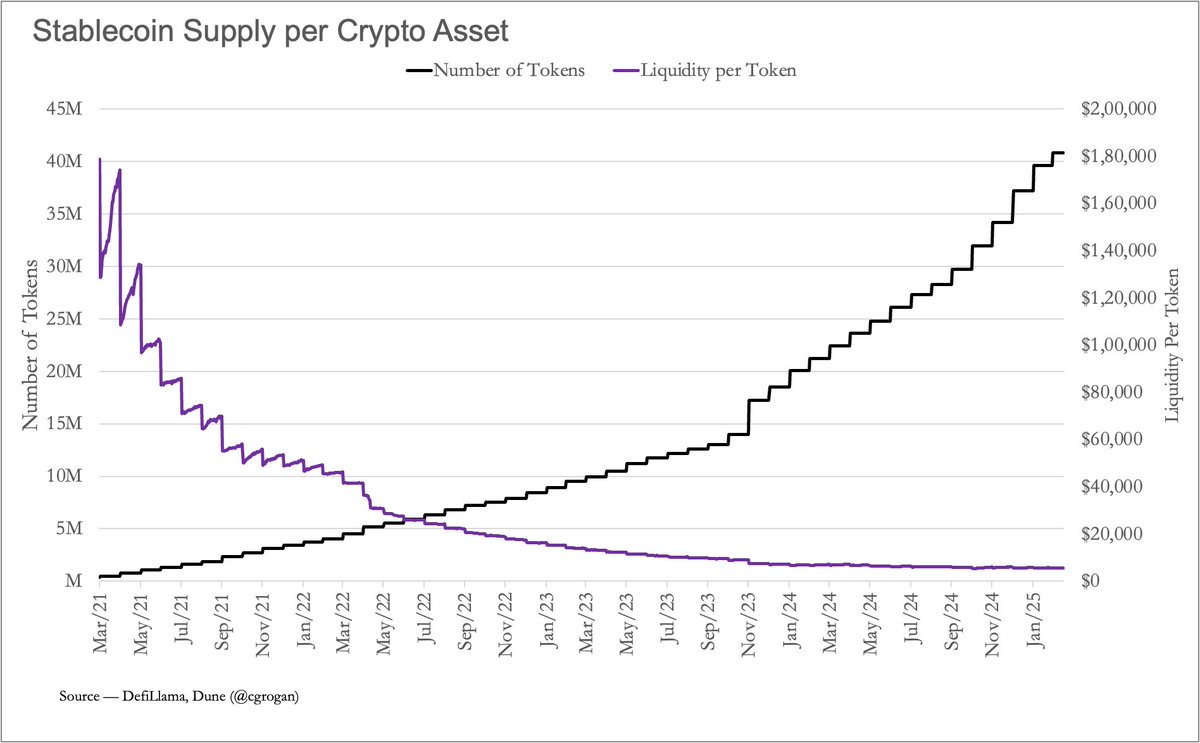
This chart visually demonstrates the decline in averages while also reflecting the nature of the zero-sum game of attention in today's crypto space. Despite the number of tokens surging to over 40 million assets, stablecoin liquidity (a rough measure of capital) has stagnated. The result is brutal—capital allocated to each project decreases, communities become weaker, and user engagement rapidly declines.
In such an environment, fleeting attention is no longer a channel for growth but a burden. Without cash flow support, this attention can shift quickly and mercilessly.
Revenue as the Anchor of Development
Most projects still build communities the way they did in 2021: creating a Discord channel, offering airdrop incentives, and hoping users will shout "GM" (Good Morning) long enough to generate interest. But once the airdrop ends, users quickly leave. This is not surprising, as they have no reason to stay. At this point, the role of cash flow becomes prominent—it is not just a financial metric but an important proof of project relevance. A product that can generate revenue indicates demand. Demand supports valuation, and valuation, in turn, gives tokens their appeal.
While revenue may not be the ultimate goal for every project, without it, most tokens cannot survive long enough to become foundational assets.
It is important to note that some projects are positioned quite differently from other parts of the industry. Take Ethereum, for example; it does not need additional revenue because it already has a mature and sticky ecosystem. Validator rewards come from an annual inflation of about 2.8%, but this inflation can be offset by the fee-burning mechanism of EIP-1559. As long as the burn and earnings can balance, ETH holders can avoid the risk of dilution.
But for new projects, they do not have such luxury. When only 20% of tokens are in circulation and you are still struggling to find product-market fit, you are essentially like a startup. You need to be profitable and prove your ability to sustain profitability to survive.
The Lifecycle of Protocols: From Explorers to Giants
Similar to traditional companies, crypto projects are at different stages of maturity. At each stage, the relationship between the project and revenue—and whether to choose reinvestment or revenue distribution—changes significantly.
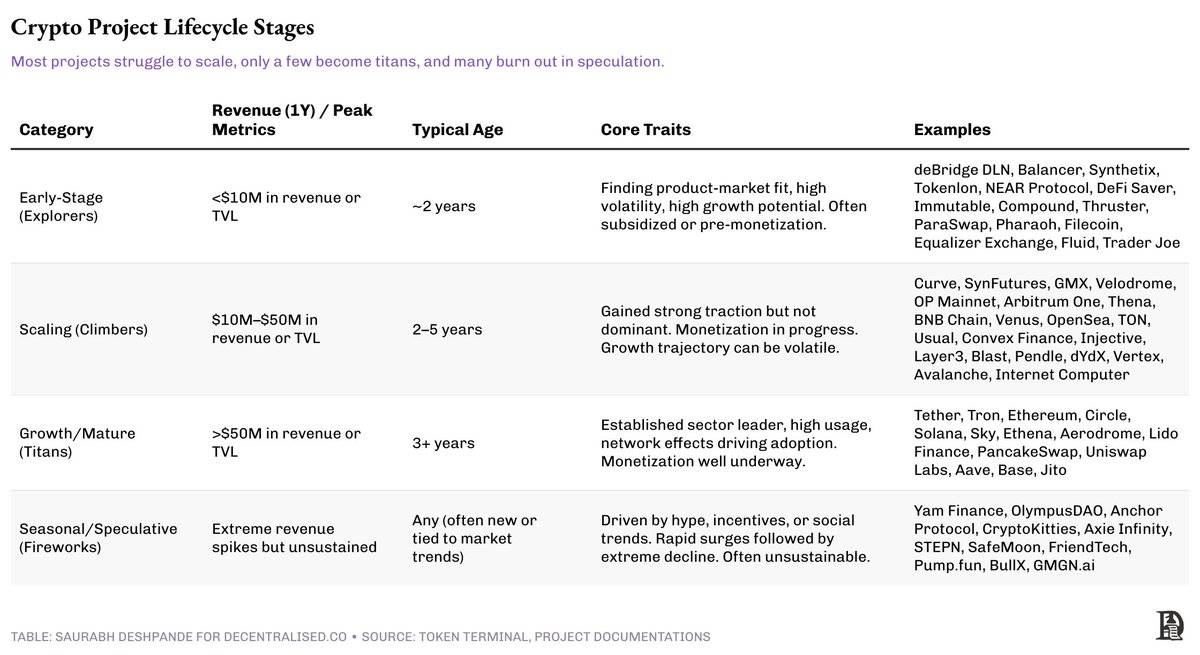
Explorers: Survival First
These are early-stage projects, often with centralized governance, fragile ecosystems, and a greater focus on experimentation rather than profitability. Even if there is revenue, it is often volatile and unsustainable, reflecting market speculation rather than user loyalty. Many projects rely on incentives, grants, or venture capital to survive.
For example, projects like Synthetix and Balancer have been around for about five years. Their weekly revenue ranges from $100,000 to $1 million, with some anomalous spikes during peak activity periods. This extreme volatility and retraction are typical characteristics of this stage; it is not a sign of failure but a manifestation of volatility. The key is whether these teams can turn experiments into reliable use cases.
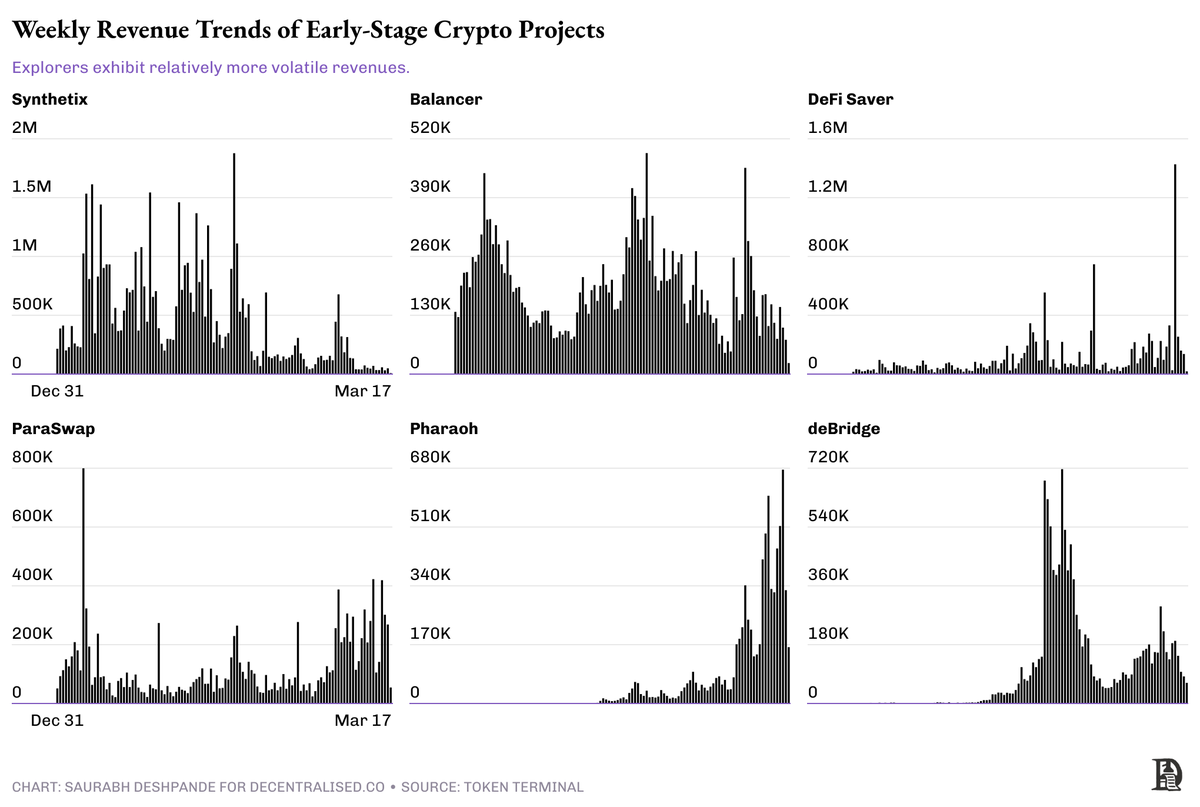
Climbers: Traction but Still Unstable
Climbers are projects in the advanced stage, with annual revenues between $10 million and $50 million, gradually moving away from a growth model reliant on token issuance. Their governance structures are maturing, and their focus is shifting from mere user acquisition to long-term user retention. Unlike explorers, climbers' revenues can demonstrate demand across different cycles, not just driven by one-off hype. At the same time, they are undergoing structural evolution—from centralized teams to community-driven governance and diversifying revenue sources.
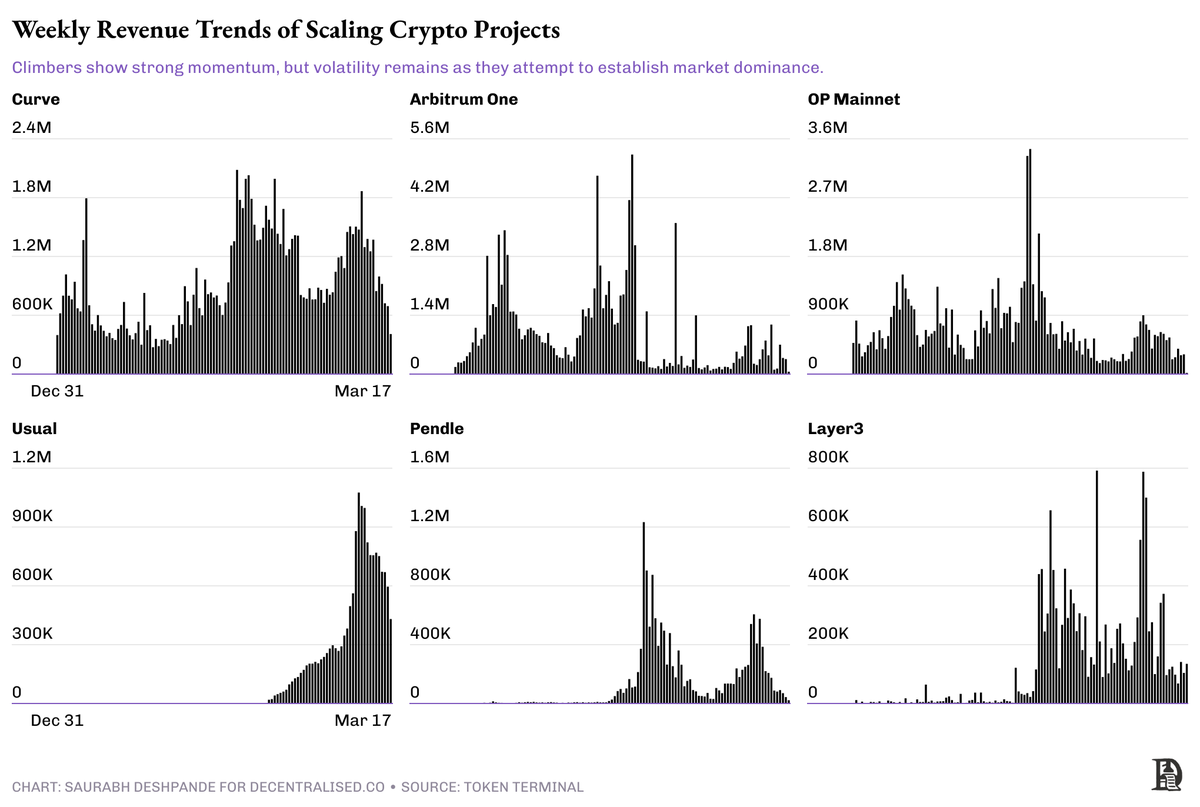
What sets climbers apart is their flexibility. They have built enough trust to experiment with revenue distribution—some projects are starting income-sharing or buyback programs. However, they also face the risk of losing momentum, especially if they overexpand or fail to deepen their competitive moat. Unlike explorers, whose primary task is survival, climbers must make strategic trade-offs: should they choose growth or consolidation? Should they distribute revenue or reinvest? Should they focus on core business or diversify?
The vulnerability at this stage lies not in volatility but in the stakes becoming real and visible.
These projects face the toughest choices: distributing revenue too early may hinder growth, but waiting too long may cause token holders to lose interest.
Giants: Ready to Distribute
Projects like Aave, Uniswap, and Hyperliquid have crossed the threshold. They can generate stable revenue, have decentralized governance, and benefit from strong network effects. These projects no longer rely on inflationary token economics; they have a solid user base and market-validated business models.
These giants typically do not attempt to "do it all." Aave focuses on the lending market, Uniswap dominates spot trading, while Hyperliquid is building an execution-centric DeFi stack. Their strength comes from defensible market positioning and operational discipline.
Most giants are leaders in their respective fields. Their efforts are often focused on "growing the pie"—that is, driving overall market growth rather than simply expanding their market share.
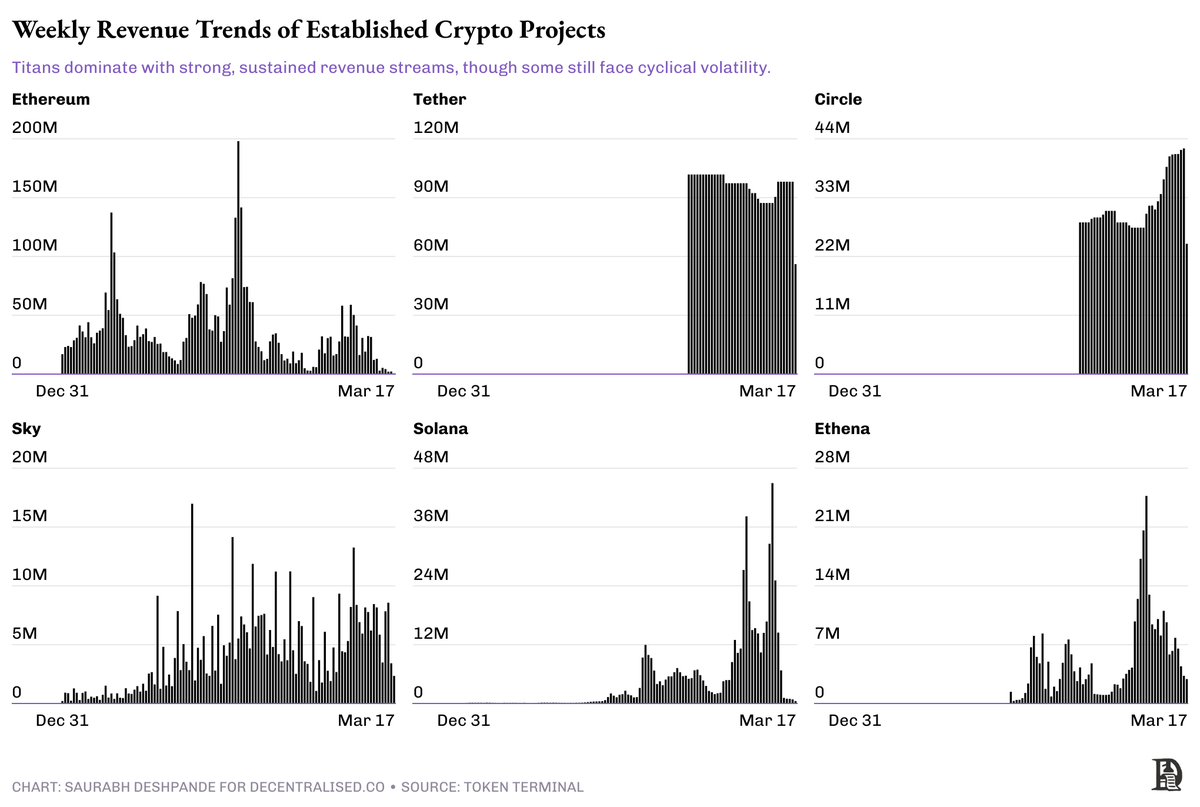
These projects are the type that can easily conduct buybacks and still maintain operations for years. While they are not completely immune to volatility, they possess enough resilience to navigate market uncertainties.
Seasonal Players: Buzzing but Lacking Foundation
Seasonal players are the most eye-catching yet the most fragile type. Their revenues may rival or even exceed those of giants in a short time, but these revenues are primarily driven by hype, speculation, or fleeting social trends.
For example, projects like FriendTech and PumpFun can generate massive engagement and trading volume in a short time but rarely convert these into long-term user retention or sustained business growth.
These projects are not inherently bad. Some may pivot and evolve, but most rely on short-term market momentum rather than building lasting infrastructure.
Lessons from the Public Market
The public stock market provides a useful analogy. Young companies typically reinvest free cash flow to scale, while mature companies distribute profits through dividends or stock buybacks.
The chart below shows how companies allocate profits. As companies grow, the number of companies that pay dividends and conduct buybacks both increase.
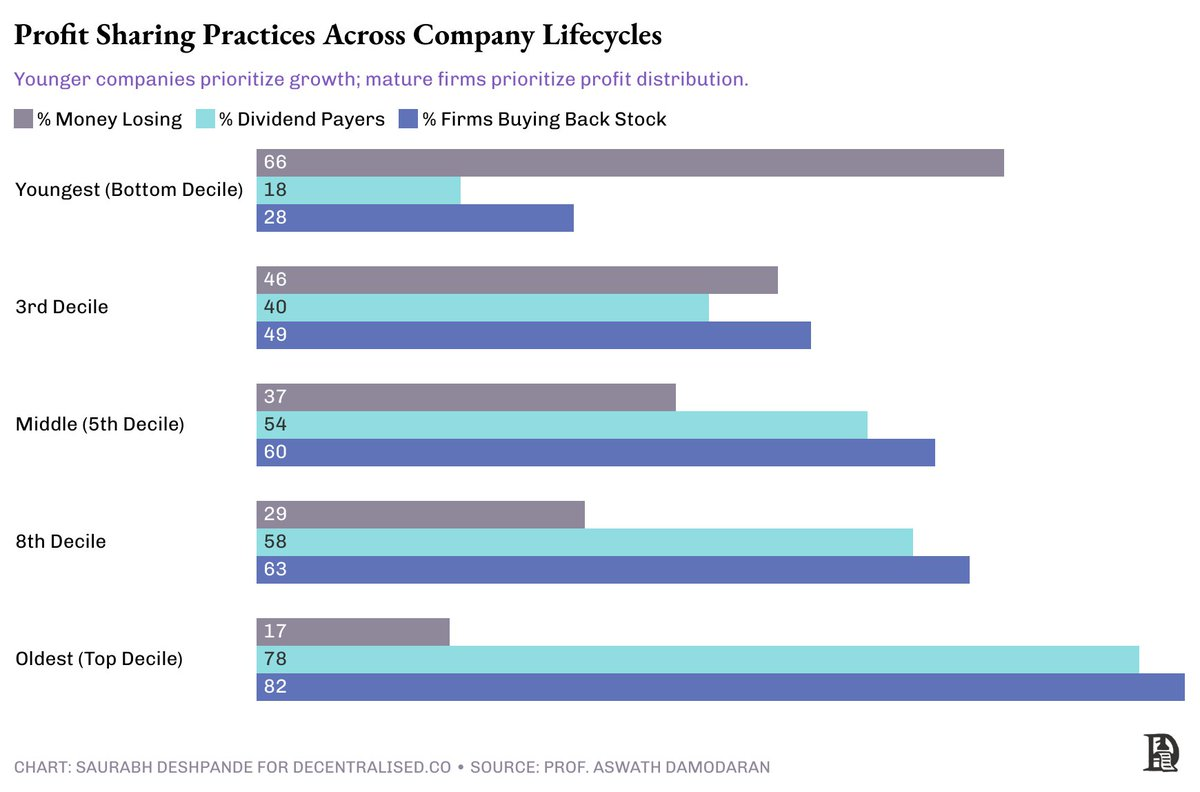
Crypto projects can learn from this. Giants should distribute profits, while explorers should focus on retention and compounding growth. However, not every project is clear about which stage it belongs to.
Industry characteristics are also important. Utility-like projects (such as stablecoins) are more like consumer necessities: stable and suitable for dividends. This is because these companies have been around for a long time, and demand patterns are largely predictable. Companies often do not deviate from forward-looking guidance or trends. Predictability allows them to continuously share profits with shareholders.
In contrast, high-growth DeFi projects are more like the tech industry— the best way to allocate value is through flexible buyback programs. Tech companies often experience higher seasonal volatility. In most cases, their demand is not as predictable as in some more traditional industries. This makes buybacks the preferred method for sharing value.
If a quarter or year performs exceptionally well? Share value through stock buybacks.

Comparison of Dividends and Buybacks
Dividends are sticky. Once a commitment to pay dividends is made, the market expects consistency. In contrast, buybacks are more flexible, allowing teams to adjust the timing of value distribution based on market cycles or when tokens are undervalued. From about 20% profit distribution in the 1990s to about 60% in 2024, buybacks have rapidly grown over the past few decades. In dollar terms, buyback volumes have surpassed dividends since 1999.
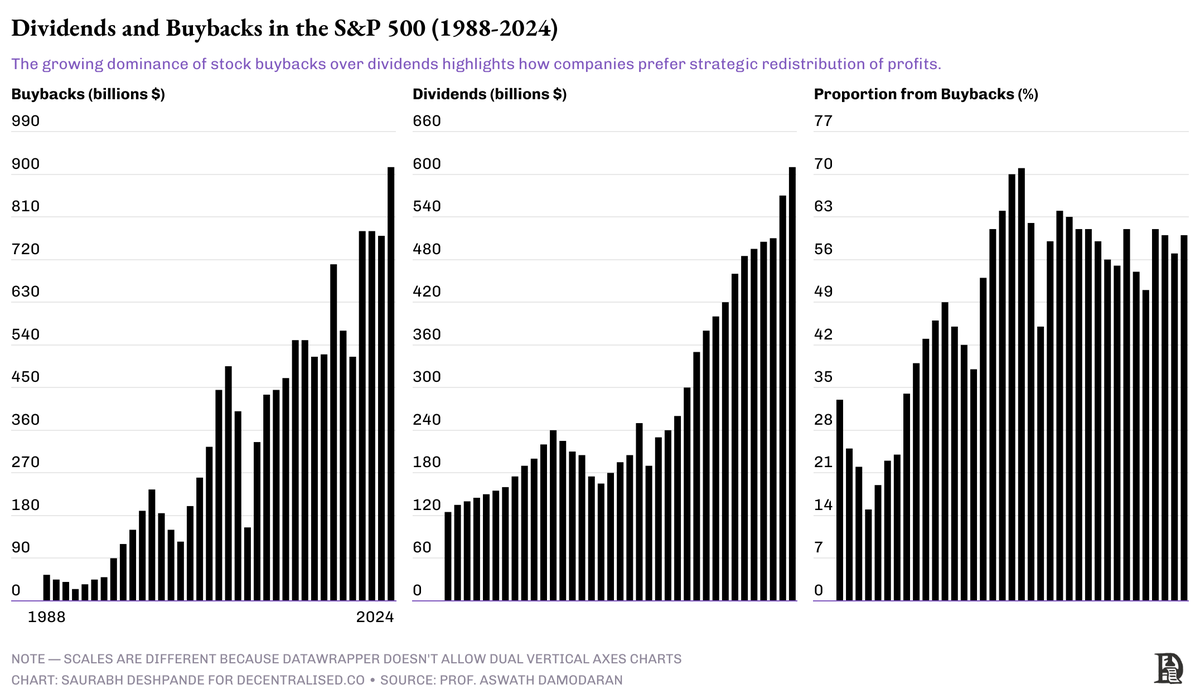
However, buybacks also have downsides. If not communicated properly or priced incorrectly, buybacks can transfer value from long-term holders to short-term traders. Additionally, governance mechanisms need to be very tight, as management often has key performance indicators (KPIs) such as earnings per share (EPS) to meet. When a company uses profits to buy back shares in circulation (i.e., outstanding shares), it reduces the denominator, artificially inflating EPS figures.
Dividends and buybacks each have their applicable scenarios. However, without good governance, buybacks can quietly benefit insiders at the expense of the community.
Three Key Elements of Good Buybacks:
Strong asset reserves
Thoughtful valuation logic
Transparent reporting mechanisms
If a project lacks these conditions, it may still need to be in the reinvestment phase rather than conducting buybacks or dividends.
Current Revenue Distribution Practices of Leading Projects
@JupiterExchange clearly stated at the time of the token launch: they do not directly share revenue. After achieving a tenfold user growth and having enough capital reserves to sustain operations for years, they launched the "Litterbox Trust"—a non-custodial buyback mechanism that currently holds approximately $9.7 million in JUP tokens.
@aave has over $95 million in asset reserves and allocates $1 million weekly for buybacks through a structured program called "Buy and Distribute." This program was launched after months of community discussions.
@HyperliquidX goes a step further, using 54% of its revenue for buybacks and 46% to incentivize liquidity providers (LPs). To date, over $250 million in HYPE tokens have been repurchased, fully supported by non-venture capital funds.
What do these projects have in common? They all began implementing buyback programs only after ensuring their financial foundations were solid.
The Missing Link: Investor Relations (IR)
The crypto industry is keen on discussing transparency, but most projects only disclose data when it benefits their narrative.
Investor relations (IR) should be a core infrastructure. Projects need to share not only revenue but also expenses, capital reserves (runway), asset reserve strategies, and buyback execution status. Only in this way can confidence in long-term development be established.
The goal here is not to claim that a certain value distribution method is the only correct one, but to acknowledge that the distribution method should match the maturity of the project. In the crypto space, truly mature projects are still rare.
Most projects are still searching for their footing. However, those that have done it right—projects with revenue, strategy, and trust—have the opportunity to become the "church" that the industry desperately needs (a long-term stable benchmark).
Strong investor relations serve as a moat. They can build trust, alleviate panic during market downturns, and maintain ongoing participation from institutional capital.
Ideal IR practices may include:
Quarterly income and expense reports
Real-time asset reserve dashboards
Public records of buyback execution
Clear token distribution and unlocking plans
On-chain verification of grants, salaries, and operational expenses
If we want tokens to be viewed as true assets, they need to start communicating like real businesses.
免责声明:本文章仅代表作者个人观点,不代表本平台的立场和观点。本文章仅供信息分享,不构成对任何人的任何投资建议。用户与作者之间的任何争议,与本平台无关。如网页中刊载的文章或图片涉及侵权,请提供相关的权利证明和身份证明发送邮件到support@aicoin.com,本平台相关工作人员将会进行核查。




